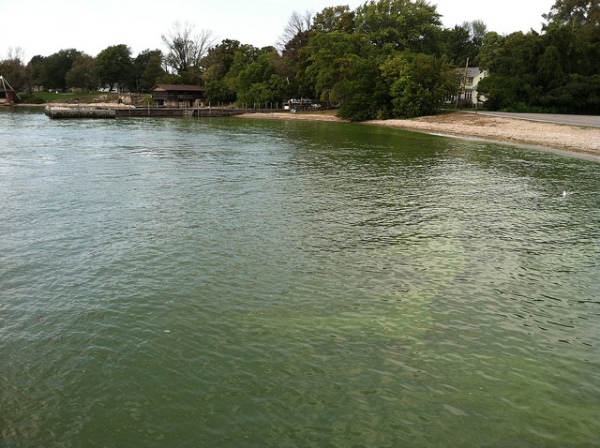When a summer storm crosses the eastern plains, drowning farmlands in a deluge, more than water ends up flowing into Colorado’s rivers, lakes and streams.
On April 13, 2017, the Colorado Foundation for Water Education was joined by Troy Bauder, with Colorado State University Extension, for a webinar in which part of the discussion centered on nonpoint source pollution. Bauder focuses on working with agricultural producers to reduce nutrient losses on their fields.
Runoff, a nonpoint source, occurs when there is more water than the soil can absorb. Agricultural runoff carries a bit of everything it touches—excess fertilizer, animal waste, soil and more. Water that is not absorbed into the ground moves across the land, picking up whatever it can carry, and drains into surface water and groundwater sources.

Photo Credit: Lynn Betts
“Ag nutrients—nitrogen (N) and phosphorus (P)—are absolutely required for productive agriculture,” Bauder says. “Of course, we need good management to prevent the accumulation of too much N and P in our soils and to reduce the potential for movement to surface and ground water.”

Photo Credit: Dr. Jennifer L. Graham
When nitrogen and phosphorus—two nutrients found in agricultural runoff—are deposited in excess in water bodies, it leads to algal blooms, reduced dissolved oxygen content, which is harmful to aquatic plants and animals, and can compromise drinking water supplies.
If rain falls on 30 farms, with 20 of them using fertilizers to supplement nutrients in the soil, and the excess of these nutrients finds its way into the runoff, who is to blame for compromising water quality? Who is responsible for nutrient pollution? Since no one farm can be blamed for the degradation of water quality, agricultural runoff is a challenging nonpoint source pollutant to manage and regulate.

Photo Credit: USDA
Colorado’s Regulation 85, a nutrient policy passed in 2012, regulates point sources of nitrogen, phosphorous and chlorophyll a in surface water, setting discharge limits and requiring monitoring; however, Regulation 85 currently allows for a voluntary, incentivized, approach for reducing nutrient pollution that originates in nonpoint source pollution.
“We’ve partnered with CDPHE [the Colorado Department of Public Health and Environment] to produce some resources and an outreach program called Colorado AG Water Quality,” Bauder continues. “The purpose of this outreach effort is to get the word out to growers about how Reg. 85 could potentially affect them.”

Photo Credit: USDA
Taking ownership of nutrient pollution and implementing best management practices gives agriculture the opportunity to avoid stringent state regulations. In 2022, the current, voluntary, approach will be evaluated to determine if progress has been made with the implementation and adoption of best management practices (BMP) as they relate to nonpoint source pollution, agriculture and water quality. Additional regulations may be considered depending on the results.

Conservation Tillage Photo Credit: USDA
Reducing nutrient pollution is achieved through the implementation of BMPs, including improvements in fertilizer management, conservation tillage, irrigation, manure handling and soil erosion. The adoption of BMPs by Colorado agricultural producers benefits agriculture, as well as water quality. When implemented successfully, not only will there be a reduction in nutrient pollution, but it will reduce the need for future regulation.
“We want to work with our growers on the agronomic and economic feasibility of these practices to help them understand how they can help their bottom line,” Bauder says.

Nitrogen Application Photo Credit: Bob Nichols
BMP effectiveness depends on what is known as the 4 R’s: Growers need to use the right amount (rate), right placement, right timing and right source. Combined with improved irrigation management, these BMPs improve the efficacy of the nutrients and prevent the potential for movement, which often results in nonpoint source pollution. Irrigation management can include altering the method by which water is delivered with system upgrades, combined with scheduling watering at the right time of day and in the proper amounts to reduce runoff. Ultimately, implementing these BMPs will benefit the grower’s bottom line while simultaneously protecting water sources from being impacted by nutrients.

Photo Credit: USDA
“It’s definitely important to engage growers early and often in the process,” Bauder concludes. “Not only the growers, but their representatives, commodity groups and the people who advise them.”
While nutrients are certainly necessary for successful and sustainable agriculture, the execution of BMPs will help mitigate nutrient loss and movement, and in turn, reduce nonpoint source pollution due to runoff. Providing incentives, tools and resources to growers is critical to BMP implementation and success, as well as keeping Colorado’s water sources clean and reducing the impact of nutrient pollution.

Photo Credit: NOAA
Learn more about cyanotoxins, algal blooms, public health and efforts to reduce nutrients in our water when you listen to the recording of this April 2017 webinar presented by the Colorado Foundation for Water Education and offered in partnership with Colorado Water Congress with support from the Colorado Department of Public Health and Environment. Hear about how municipal recreational lakes are monitoring and working to reduce algal blooms, discover how agricultural producers coming together and implementing best practices to minimize nutrient runoff and learn the basics of toxic algal blooms.
 Find further coverage about this topic in the Public Health Issue of Headwaters Magazine.
Find further coverage about this topic in the Public Health Issue of Headwaters Magazine.
Not a Headwaters subscriber? Visit yourwatercolorado.org for the digital version. Headwaters is the flagship publication of the Colorado Foundation for Water Education and covers current events, trends and opportunities in Colorado water.

 Print
Print
Reblogged this on Coyote Gulch.